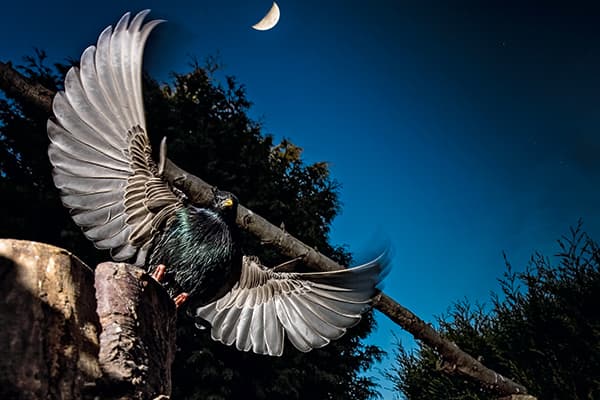
Nightwing
Canon EOS 5D Mark III, 16-35mm, 1/200sec at f/14, ISO 160, flash
Turning my back garden into a photo location was a response to my need to find an outlet for my photography following redundancy and then a change of job. Both of these had reduced my free time and access to my favourite wildlife areas.
I had started the project the previous year with a small patch in the garden, probably around two square metres in size. I then added a bird table, a feeding station and some plants known to be attractive to birds: lavender and clematis to attract insects, pyracantha for its berries and dogwood for cover.
All the information for this, and suggestions for the best feeds to attract different birds, I got from the RSPB website (rspb.org.uk). The site is useful although not definitive, as I’ve found birds don’t stick strictly to the rules concerning what they should or shouldn’t eat. That’s where one’s own observations and experiments are essential.
Fast forward a year or so and, as I said, I was made redundant from my job. That wasn’t really a problem as I found a job at a local special-needs school. It’s a great role, very fulfilling, and it’s nice to feel I’m helping the school that did so much for our kids (we have twins with disabilities). The one downside, apart from its being only temporary until summer, was that the hours I worked, and the care we must give our twins and other son, meant I had lost my access to the local marshes that I used to visit on my way to and from my previous job.
I had to do something to keep my photography going within the constraints I had, so I began to look at the garden again and ways I could use the feeding area a little more creatively. It began slowly – moving a few things around, adding some small logs and tree offcuts for a more natural look, but keeping the main feeding station and bird table to attract the birds.
I struggled with the idea of baiting these ‘natural’ areas for a long time, as I had always preferred to go out and find my subjects rather than make them come to me. Honestly, it felt like cheating. In the end, I decided to stick with feeding them as I figured that, at the end of the day, all I was doing was providing the birds with a more natural-looking feeding environment.
To achieve this, I drilled out or cut sections into the logs, which could hold various foodstuffs. It’s personal preference, but to keep the natural look, all the holes or sections were placed where they would not show up much on camera.
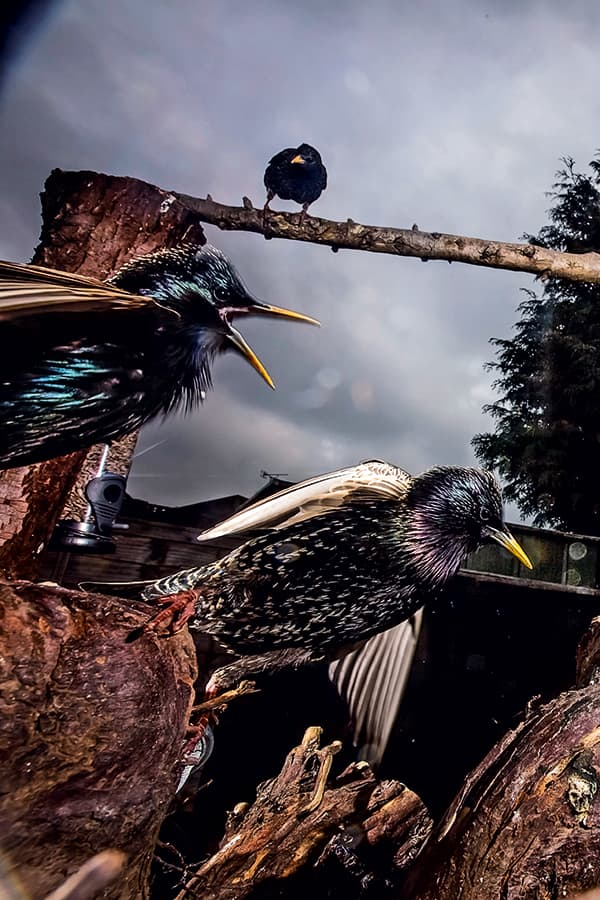
A Call to Arms
Canon EOS 5D Mark III, 16-35mm, 1/200 at f/18, ISO 100, flash
No-show subjects
I watched these areas for activity routines and bird types to get an idea of what to expect and when, as well as which food types worked best for which bird. When I was satisfied I had at least a rough idea, I set up the chair hide, which had been sitting unused in the shed for the previous six months.
I don’t like hides when I’m out shooting. A throw-over is fine, but unfortunately I’m too impatient a person to sit in a hide for hours, because I always feel as if I’m missing something that’s around the corner. However, seeing as I wouldn’t be going anywhere, I thought I’d give it a try.
It turned out to be a massive failure, even though I left the hide out for over a week for the birds to get comfortable with it. Every time I went in it, the birds were a no-show. It seemed to me that it was a combination of not only my presence but also that the times I had available weren’t exactly peak feeding periods.
From observation, I noted the peak feeds were at times when there was no way I would be able to get out, specifically in the morning when I would be feeding and dealing with getting the twins ready for school, and evening time when they got back. The rest of the day I would be at work, so this was a problem. I wasn’t about to give up, though, so I explored the option of using Magic Lantern, which I had previously installed on my Canon EOS 550D and 5D Mark III, but had only used for things such as focus stacking.
Looking at the options, I realised it could trigger the shutter by motion detection or trap focus.
This gave me the idea of focusing the camouflaged camera on the target area and leaving it to capture the images. This worked to a degree – the birds did not seem bothered by the camera and it did capture some images, but there were some big limitations.
Motion detection was hit and miss, and did not work on the 5D Mark III at all. After much frustration, and thinking I had set it incorrectly, I discovered on the internet that there was a bug on the 5D Mark III firmware and motion detection was a no-go.
Even using the 550D, I found the results lacked consistency. Sometimes it would fire, other times not. I then took to using the trap focus feature, this time with greater success. With the trap focus, I was able to set a single focus point that would trigger the shutter if a subject entered the focus plane at that point. To do this, I would place an object in the area I wanted to capture, focus on it, then switch the lens to manual focus and remove the object. It was more consistent with the triggering and I do still use it occasionally now, but I still wasn’t happy with the fact I had no control over when the shutter fired. I felt there must be a better way.
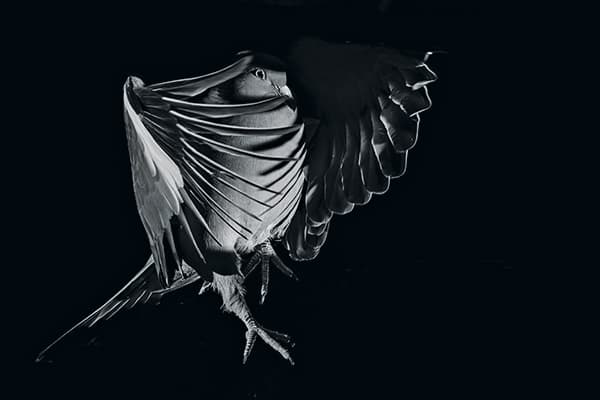
Out of Darkness
Canon EOS 5D Mark III, 400mm, 1/200sec at f/18, ISO 200, flash
Flash photography
I dug out some old wireless flash triggers (Yongnuo RF-603C) that I had bought a while earlier, half remembering something about them being able to double as a remote trigger. With these I was able to put the camera pretty much anywhere I wanted in the garden, conservatory or shed and still remotely trigger the shutter. This was a much better approach because between dealing with the kids and having more control over the shots, I could keep an eye on what was going on. But I still wasn’t happy. I didn’t like the backgrounds on a lot of the shots. They didn’t do the birds justice and just blended in.
I already had a Yongnuo YN-622C controller and receivers, as well as a couple of Yongnuo flashes with TTL and a very basic Godox, one with a slave function. I thought about the idea of using flash, so I did a bit of research into the matter, mainly to see if it would have an adverse effect on the birds. However, many sources claimed low-level flash would be unlikely to cause harm.
I began with a two-flash set-up on one of the small logs, with both flashes at about 45° from the log to give an even light. I started with the flashes on an extremely low setting and worked up the power while observing the birds’ reactions. Initially they were startled by the flash, but soon returned to feeding, and over the next few days I kept experimenting with flash power.
The starlings didn’t seem bothered, so they became my main subjects and I began to get more of the look I wanted. It still wasn’t quite what I was after, though, so I brought in the slave flash to the rear to give some backlighting.
This didn’t fire consistently so I bought another receiver to go with the YN622. That fixed it. I now had a three-flash set-up, two of which I could control from the camera.
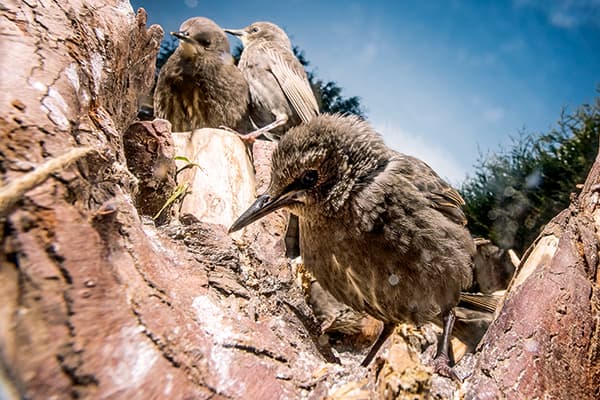
Fancy Seeing You Here
Canon EOS 5D Mark III, 16-35mm, 1/200sec at f/16, ISO 125, flash
Refining the environment
While I was playing around with these ideas, I also improved the feeding area. I swapped the bird table for a large tree stump which, when upturned, had numerous nooks and crannies the birds could hunt for food in, giving the images a natural look. I drilled and cut it with additional feed areas. I also built a small reflecting pool by using a 2x1m piece of ply around which I screwed 6in pieces of timber to make a rectangular pool shape.
I lined it with heavy-duty black polythene (apparently black is best for the reflections) and then built up a small incline at the far end, using slate I had in the garden, to give the birds a bathing and drinking area. I finished it off by covering it with artificial grass.
So far I haven’t used it much for photography, but a large water source is always good for attracting birds to a garden.
On the subject of attracting the birds, over the past year I have found the most consistently effective foodstuffs to be mealworms, suet logs – which you can mould and stick in the logs – and sunflower hearts. However, as I said earlier, because they work in my garden doesn’t mean they will work elsewhere.
It was all starting to take shape. I’d got the camera and flash settings about right (1/200sec on the EOS 5D Mark III or 1/250sec on the 7D Mark II, between ISO 50 and 200, f/14 and flash at between 1/16-1/4 power), and the area was getting a lot of air traffic, mainly starlings but other bird species were starting to investigate.
The background still bothered me, as I had to spend time editing to get rid of unsightly reflections, so I stapled some black capillary matting to the fence and that solved the problem. I started to get some images that I really liked and felt were a little different from the ‘normal’ wildlife shots. The final addition was a large perch above the area, which gave the birds a place in which to congregate and meant I could have a more predictable way of catching them in flight.
Now it’s all set up as I want it (for the time being, at least). I can play around with different ideas concerning lighting, camera placement and angles.
For the most part, the birds are fairly nonchalant. I’ve even had the camera centimetres away from them with a wideangle lens. Covering the flash units with clear Ziploc bags allows me to shoot in the rain, and that gives an interesting, almost starlit look.
As I said, it’s still evolving, but it gives me something to do between my trips out to photograph ‘real’ wildlife, as well as ideas I can possibly use in the field.
Adrian’s kit list
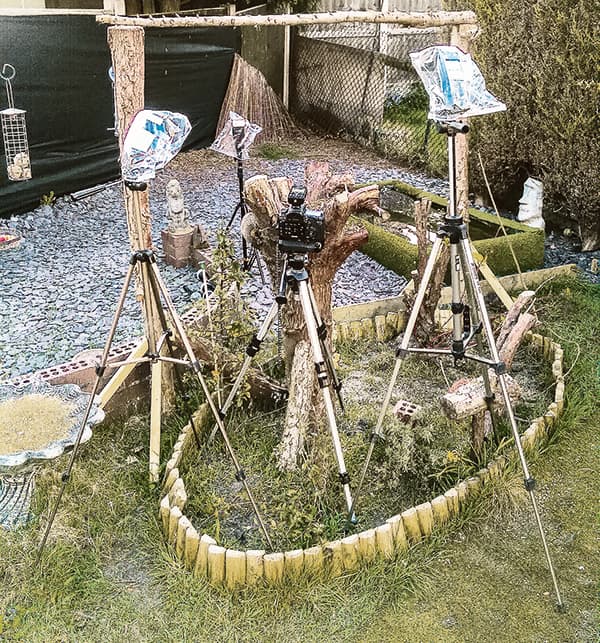
Adrian’s set-up in his back garden
Canon EOS 5D Mark III, Canon EOS 7D Mark II, Canon 16-35mm lens, Canon 400mm lens, Sigma 150-600mm lens, Yongnuo YN62c flash trigger and three receivers, Yongnuo RF-603c remote triggers, two Yongnuo 568ex flash units, one Godox basic flash, three charity shop tripods for flashes, one Vanguard tripod for camera.
About Adrian Clarke

Adrian Clarke, 42, is based in Staffordshire. He has been shooting since picking up a Praktica MTL5 at school and enjoys experimenting with new techniques, especially in relation to wildlife photography. You can see more of his work at www.ajc1173.wix.com/clarkepictures or on Flickr at www. flickr.com/photos/ 92460969@N05

